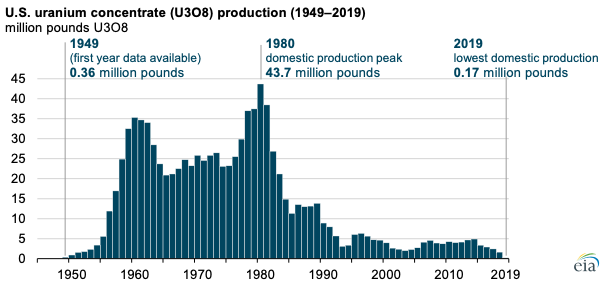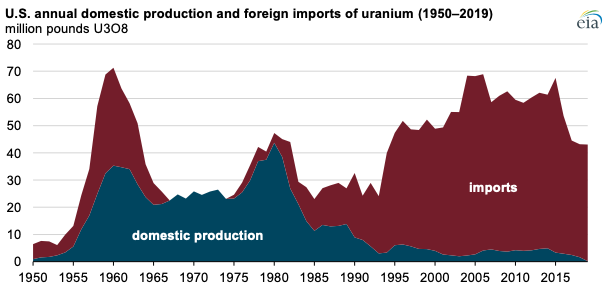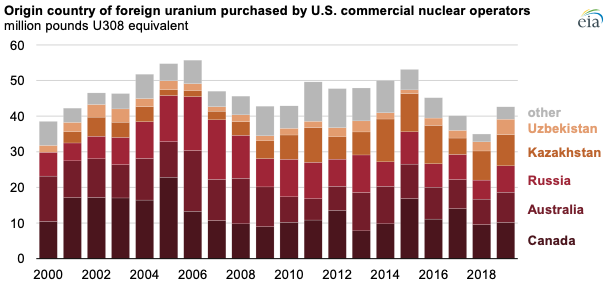The United States produced 174,000 pounds of uranium concentrate (U3O8) in 2019, 89% less than in 2018 and the lowest amount produced since the U.S. Energy Information Administration’s (EIA) data series began in 1949. Domestic U3O8 production has declined since its peak of 43.7 million pounds in 1980.

Producing uranium concentrate, U3O8, is the first step in nuclear fuel production. After the uranium ore is mined, it goes through a milling process that extracts uranium from the ore, producing uranium concentrate (U3O8). Although the original ore contains as little as 0.1% uranium, U3O8 is usually more than 80% uranium. U3O8 is then processed at conversion and enrichment facilities, where it’s made into reactor fuel pellets. Fuel fabrication plants assemble the fuel pellets into fuel rods for use in commercial nuclear reactors.
In the late 1940s and early 1950s, the United States introduced incentives and trade policies encouraging the growth of domestic uranium production. After these policies ended in the 1980s, domestic production began to decline. Other countries, such as Canada and Australia, have more accessible, high-quality uranium deposits, allowing them to produce U3O8 at a lower cost than the United States. Since 1990, purchased imports of U3O8 have exceeded domestic U3O8 production each year.

Owners and operators of commercial nuclear power reactors buy uranium in the form of U3O8, uranium hexafluoride, or enriched uranium, or a combination of these forms. When the uranium is purchased earlier in the fuel cycle, such as in the form of U3O8, owners and operators pay for conversion, enrichment, and fabrication into fuel rods. In 2019, the fuel assemblies, or structured groups of fuel rods, loaded into U.S. commercial reactors contained 43.2 million pounds of U3O8. About 9% of this amount was U.S.-origin, and 91% was foreign-origin.
In 2019, U.S. commercial nuclear power reactor operators purchased a total of 48.3 million pounds of U3O8. Foreign imports of U3O8 supply the majority of fuel to U.S. commercial nuclear reactors, and 42.6 million pounds, or 88% of the total U3O8 purchased, were imported in 2019.
Canada, which has large, high-quality uranium reserves, has historically been the largest source of U.S. uranium imports. In 2019, Canada remained the largest source of imports of uranium supplied to U.S. civilian nuclear power plants, followed by Kazakhstan, Australia, and Russia. Subsidies for uranium producers in Kazakhstan have led to increases in the country’s uranium exports, including those to the United States.

Domestic production and imports of uranium have declined in recent years as a result of decreased demand for U3O8 as more U.S. commercial nuclear reactors retire from service. The United States currently has 95 operating commercial nuclear reactors at 57 nuclear power plants. Most recently, Indian Point Unit 2, near New York City, retired in April 2020. Iowa’s Duane Arnold Energy Center is scheduled to retire later in 2020, and Indian Point Unit 3 is scheduled to retire in 2021. By 2025, three additional reactors at two plants are expected to retire, according to data reported to EIA.
Principal contributor: Slade Johnson

Follow us on social media: